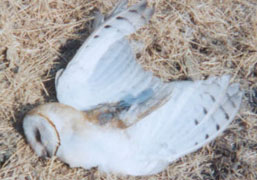 |
| Owl is among an estimated 800 to 1,300 birds killed every year by Altamont Pass wind turbines. (Photo by BioResource Consultants) |
The half-dozen owner/operators of 5,400 wind turbines in the Altamont Wind Farm east of Livermore, Calif., have been given 13 years by Alameda County supervisors to repower using bird-friendly technology at one of the oldest, largest and deadliest wind farms in the world.
"Its a win-win," says Felicia Sara Moore-Jordan, a supervisors aide who explained the requirement to phase in taller, more efficient machines as a prerequisite for continuation of a conditional-use permit at a cost to operators estimated by the board at about $540 million. Operators also must shut down 2% of the deadliest turbines as determined by a 2004 California Energy Commission study, remove "derelict" non-operating turbines and perform phased-in seasonal shutdowns during the winter when the wind power is the lowest and the most birds are flying through the hills. Operators testified that the last two actions would reduce wind production by 9% and cost them $3.7 million.
The decision was a compromise between the generators and environmentalists who had enlisted California Attorney General Bill Lockyer in a plan to require changes on a much faster timeline to save thousands of birds caught in the fast-moving blades and high-voltage lines each year. The 65-acre site is in the line of a migratory bird path and adjacent to a golden eagle nesting ground. The supervisors' goal is to reduce avian deaths by 50%.
Steve Stengle, a spokesman for Juno Beach, Fla.-based FPL Energy, says last year his company replaced 169 wind turbines with 31 more efficient models to produce roughly the same amount of energy. "Technology is changing so rapidly that it is difficult to guess what we will be purchasing 13 years from now or how much it will cost," he says. "The goal is always to have fewer, taller turbines with slower rotor speed to reduce avian mortality and increase efficiency." Today, the cost of 1 MW of turbine generation runs between $1 million and $1.3 million and a properly maintained turbine can last 25 years. An estimated 500 MW of production are located in the Altamont Hills.
North Palm Springs, Calif.-based enXco, another large Altamont Wind Farm operator, voluntarily shut down 109 turbines for a month last January to explore aspects of the seasonal-shutdown measure. Operators will also perform an environmental-impact report and pay for monitoring and an independent scientific review committee.

Post a comment to this article
Report Abusive Comment